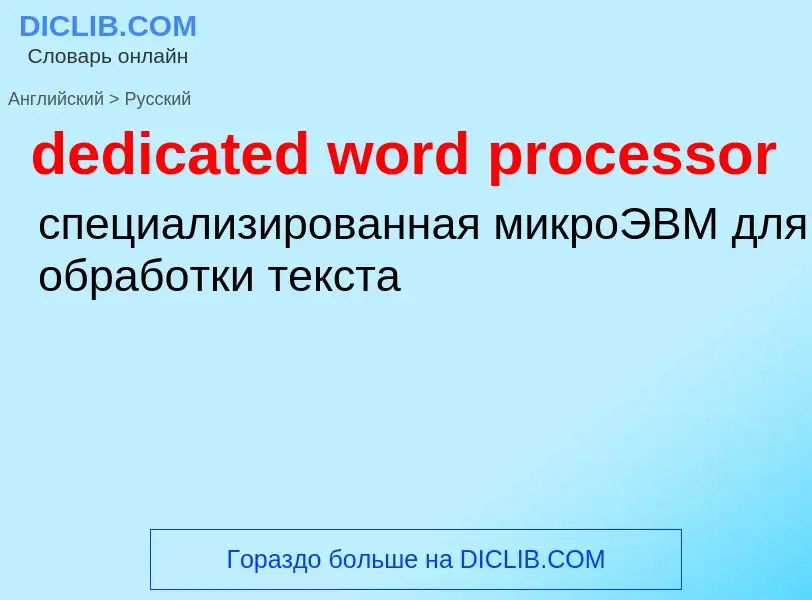Перевод и анализ слов искусственным интеллектом ChatGPT
На этой странице Вы можете получить подробный анализ слова или словосочетания, произведенный с помощью лучшей на сегодняшний день технологии искусственного интеллекта:
- как употребляется слово
- частота употребления
- используется оно чаще в устной или письменной речи
- варианты перевода слова
- примеры употребления (несколько фраз с переводом)
- этимология
dedicated word processor - перевод на русский
общая лексика
выделенный сервер
сетевой компьютер, предназначенный для работы только в качестве сервера, например сервера печати
Смотрите также
общая лексика
размер слова
определяется архитектурой процессора. Термин чаще всего ссылается на число разрядов, которое может одновременно передаваться по шине данных или храниться и обрабатываться в регистрах процессора. Обычно это 8, 16, 32 или 64 разряда. В ЭВМ первого и второго поколения, когда не было понятия байта, термин буквально относился к длине машинного слова
общая лексика
длина слова
число символов или разрядов в слове
длина кодовой комбинации
Смотрите также
[mə'ʃi:nwə:d]
общая лексика
машинное слово
группа разрядов оперативной памяти, выбираемая процессором за одно обращение (или обрабатываемая им как единая группа), обычно содержит 16, 32 или 64 разряда. Разрядность машинного слова называется его длиной
синоним
математика
двоичное слово
общая лексика
блок обработки данных
нефтегазовая промышленность
нефтехимическая установка, технологическая установка для нефтепереработки
обрабатывающее устройство
Определение
Википедия

A word processor is an electronic device (later a computer software application) for text, composing, editing, formatting, and printing.
The word processor was a stand-alone office machine developed in the 1960s, combining the keyboard text-entry and printing functions of an electric typewriter with a recording unit, either tape or floppy disk (as used by the Wang machine) with a simple dedicated computer processor for the editing of text. Although features and designs varied among manufacturers and models, and new features were added as technology advanced, the first word processors typically featured a monochrome display and the ability to save documents on memory cards or diskettes. Later models introduced innovations such as spell-checking programs, and improved formatting options.
As the more versatile combination of personal computers and printers became commonplace, and computer software applications for word processing became popular, most business machine companies stopped manufacturing dedicated word processor machines. As of 2009 there were only two U.S. companies, Classic and AlphaSmart, which still made them. Many older machines, however, remain in use. Since 2009, Sentinel has offered a machine described as a "word processor", but it is more accurately a highly specialised microcomputer used for accounting and publishing.
Word processing was one of the earliest applications for the personal computer in office productivity, and was the most widely used application on personal computers until the World Wide Web rose to prominence in the mid-1990s.
Although the early word processors evolved to use tag-based markup for document formatting, most modern word processors take advantage of a graphical user interface providing some form of what-you-see-is-what-you-get ("WYSIWYG") editing. Most are powerful systems consisting of one or more programs that can produce a combination of images, graphics and text, the latter handled with type-setting capability. Typical features of a modern word processor include multiple font sets, spell checking, grammar checking, a built-in thesaurus, automatic text correction, web integration, HTML conversion, pre-formatted publication projects such as newsletters and to-do lists, and much more.
Microsoft Word is the most widely used word processing software according to a user tracking system built into the software. Microsoft estimates that roughly half a billion people use the Microsoft Office suite, which includes Word. Many other word processing applications exist, including WordPerfect (which dominated the market from the mid-1980s to early-1990s on computers running Microsoft's MS-DOS operating system, and still (2014) is favored for legal applications), Apple's Pages application, and open source applications such as OpenOffice.org Writer, LibreOffice Writer, AbiWord, KWord, and LyX. Web-based word processors such as Office Online or Google Docs are a relatively new category.




